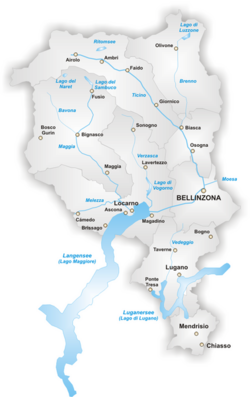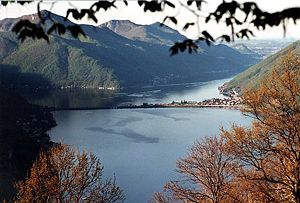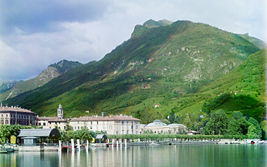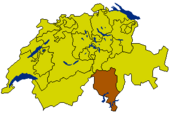Ticino
| Repubblica e Cantone del Ticino | |||
|
|||
| Capital | Bellinzona | ||
| Population (2007) | 328,580 (Ranked 8th) | ||
| - Density | 116 /km² | ||
| Area | 2812 km² (Ranked 5th) | ||
| Highest point | 3402 m - Adula (Rheinwaldhorn) | ||
| Lowest point | 195 m - Lake Maggiore | ||
| Joined | 1803 | ||
| Abbreviation | TI | ||
| Languages | Italian
executive=Consiglio di Stato |
||
| Executive | {{{executive}}} (5) | ||
| Legislative | Gran Consiglio (90) | ||
| Municipalities | 195 municipalities | ||
| Districts | 8 distretti | ||
| Website | www.TI.ch | ||
 |
|||
Canton Ticino or Ticino (Italian: IPA: [tiˈtʃiːno]; French and German: Tessin [tesɛ̃] and [teˈsiːn]) is the southernmost canton of Switzerland. The written language is Italian in almost the entire canton (except the Walser municipality of Bosco Gurin, where it is German). It surrounds the Italian exclave of Campione d'Italia. Together with areas of the canton of Graubünden it makes up the so-called Svizzera Italiana (Italian Switzerland). Lombard dialects (Ticinese) are still spoken, especially in the valleys, but they are not used for official purposes. It is named after the Ticino river.
Contents |
Geography


The canton of Ticino is located in the south of Switzerland. It is almost entirely surrounded by Italy which lies to its east, west and south. To the north lie the cantons of Valais and Uri, to the northeast the canton of Graubünden.
Its area is 2,812 square kilometers (1,086 sq mi), of which about three quarters are considered productive[1]. Forests cover about a third of the area, but also the lakes Maggiore and Lugano make up a considerable part of the total area. These lakes are known with the above listed names, but are officially named Lake Verbano and Lake Ceresio.
The canton is split geographically in two parts by the Monte Ceneri pass. The northern, more mountainous part, called Sopraceneri, is formed by the two major Swiss valleys around the lake Maggiore: Ticino valley and Maggia valley. The southern part, called Sottoceneri, is the region around the Lake Lugano.
The River Ticino is the largest river in the canton. It drains most of the canton, flowing from the northwest through the Bedretto valley and the Leventina valley to enter Lake Maggiore near Locarno. Its main tributaries are the Brenno in the Blenio valley and the Moesa in the Mesolcina valley in Graubünden. The lands of the canton are shaped by the river, which in its mid portion forms a wide valley, commonly known as the Riviera.
The western lands of the canton, however, are drained by the Maggia River. The Verzasca valley is located between the Ticino river and the Maggia river. There is also a smaller area that drains directly into the Lake Lugano. Most of the land is considered within the Alps (Lepontine Alps), but a small area is part of the plain of the River Po which drains the north of Italy.
As a result of its more southerly position it is one of the warmest cantons in Switzerland. Additionally, Ticino is prone to fierce storms and has the highest level of lightning discharge in the whole of Europe.
History
In ancient times, the area of what is today Ticino was settled by the Lepontii, a Celtic tribe. Later, probably around the rule of Augustus, it became part of the Roman Empire. After the fall of the Western Empire, was ruled by the Ostrogoths, the Lombards and the Franks. Around 1100 CE it was the centre of struggle between the free communes of Milan and Como: in the 14th century it was definitively acquired by the Visconti, Dukes of Milan. In the fifteenth century the Swiss Confederates conquered the valleys south of the Alps in three separate conquests.
The Canton of Uri conquered the Leventina Valley in 1440[2]. Between 1403 and 1422 some of these lands were already annexed by forces from Uri, but subsequently lost. In a second conquest Uri, Schwyz and Nidwalden gained the town of Bellinzona and the Riviera in 1500[2]. Some of the land and the town Bellinzona itself were previously annexed by Uri in 1419 but lost again in 1422. The third conquest was fought by troops from the entire Confederation (at that time constituted by 12 cantons). In 1512 Locarno, the Maggia Valley, Lugano and Mendrisio were annexed. Subsequently, the upper valley of the Ticino River, from the St. Gotthard to the town of Biasca (Leventina Valley) was part of Canton Uri. The remaining territory (Baliaggi Ultramontani, Ennetbergische Vogteien, the Bailiwicks Beyond the Mountains) was administered by the Twelve Cantons. These districts were governed by bailiffs holding office for two years and purchasing it from the members of the League[2].
The lands of the canton of Ticino are the last lands to be conquered by the Swiss Confederation. (After the battle of Marignano in 1515 the king of France Francis I defeated the Confederates, and they gave up any further conquests.) The Val Leventina revolted unsuccessfully against Uri in 1755[2]. In February 1798 an attempt of annexation by the Cisalpine Republic was repelled by a volunteer militia in Lugano. Between 1798 and 1803, during the Helvetic Republic, the districts of Bellinzona and Lugano were separate cantons, but in 1803 the two were unified to form the canton of Ticino that joined the Swiss Confederation as a full member in the same year[2]. During the Napoleonic Wars, many Ticinesi (as was the case for other Swiss) served in Swiss military units allied with the French.
Until 1878 the three largest cities, Bellinzona, Lugano and Locarno, alternated as capital of the canton. In 1878, however, Bellinzona became the only and permanent capital.
The current constitution dates from 1997. The previous constitution, heavily modified, dates from 1830, nearly 20 years before the constitution of actual Swiss Confederation. [3]
Government
The cantonal parliament is the Grand Council (Italian: Gran Consiglio), with 90 members and the government (Consiglio di Stato) has 5 members (Consiglieri di Stato). In the both councils the members are elected with the proportional electoral system. The canton sends two deputies to the Swiss Council of States (upper house), and eight deputies to the National Council (lower house). Its regional capital is Bellinzona.
Demographics
The population of the canton is 328,580 (2007) of which 82,794 (or 25.2%) are foreigners[4]. The population density (in 2005) is 114.6 persons per km2[1]. As of 2000, 83.1% of the population spoke Italian, 8.3% spoke German and 1.7% spoke Serbo-Croatian[1].
Agriculture
- See also: Ticino (wine region)
The main agricultural production is wine, mostly merlot, a type of red wine. It is followed by horticulture, milk and cheese production.
Economy
The most important industry sectors of Ticino’s economy are financial, tourism, trade and commerce, logistics, and production[5].
Ticino is Switzerland's third largest financial center after Zurich and Geneva. The banking industry alone has 8,400 employees and generates 17% of the gross cantonal product[5]. Because of Ticino's shared language and culture, the canton's financial industry has very close ties to Italy.
The weather in the canton is often inverse to that north of the Alps. This, and a warmer climate in general, attracts many tourists from other Swiss cantons. The lakes together with the sunshine are considered attractive. Tourism is another important economic factor in the canton, employing nearly 14,000 people (9% of the canton's workforce)[5]. Because of the tourist trade there are a number of small railways in scenic areas in the mountains. Winter sports is important, despite being less developed.
The hilly slopes of the canton are used extensively for the production of hydroelectricity. The electricity produced is used at home and sold for export. There is cattle breeding in the northern areas. The production of wine is important in the canton and exported to mainly other areas in Switzerland. The vineyards are mostly concentrated in the southern half of the canton where the climate is warmer. Other agricultural produce includes corn (maize), potatoes, tobacco and vegetables.
There is also light industry, mostly concentrated around the three largest towns of Lugano, Locarno and Bellinzona[5].
The canton is well connected to the rest of Switzerland[5]. There are tunnels underneath the Gotthard massif, both for rail and road. The canton of Grisons (Graubünden) is connected with a direct coach link, whereas the canton of Valais is connected by rail through a tunnel at the Simplon Pass. There are good rail links to Milan and Rome in Italy as well as Germany via Basel and Zürich.
Education
There are two major centres of education and research located in the canton of Ticino. University of the Italian Switzerland (USI, Università della Svizzera Italiana) is the only Swiss university teaching in Italian. The University of Applied Sciences of Italian Switzerland (SUPSI, Scuola Universitaria Professionale della Svizzera Italiana), in Manno on the other hand is a professional training college focused on a practical method of teaching in the areas of applied art, economy, social work, technology and production science[5]. There is also a small American and Swiss accredited private college, Franklin College Switzerland, located above Lugano, as well as The American School in Switzerland, a K-13 international school, accepting day and boarding students.
Media
There are four daily Italian newspapers published in Ticino: Corriere del Ticino, laRegione Ticino, Giornale del Popolo and Il Grigione Italiano. These are at present the only Italian daily publications in Switzerland.[6]
Language
The official language, and the one used for most written communication, is Italian. Despite being very similar to standard Italian, Swiss Italian presents some differences to the Italian spoken in Italy due to the presence of French and German from which it assimilates words. A clear example would be the driving licence. In standard Italian it is called "patente di guida" while in Swiss Italian it becomes "Licenza di condurre", from the French "Permis de conduire". Another example is the interurban bus. In standard Italian it would be "autobus" or "corriera" while in Swiss Italian it is the "Autopostale" (because nearly all interurban lines are run by the Swiss Post). In oral communication, Ticinese varieties of Western Lombard are still well preserved, although receding in favour of Italian (especially in the cities of Lugano, Ascona and Locarno and among the younger generations). These are further subdivided into local variations, with the northern valleys speaking a dialect more closely aligned with Romansh, Switzerland's fourth official language. There is a certain amount of popular literature (poems, comedies, etc.) in Ticinese, and the national radio and sometimes televisions trasmit program in Ticinese (mainly comedies).
Religion
The population is mostly Roman Catholic (86%) with a small Protestant (7%) minority[7]. .
Districts

The Canton of Ticino is divided into 8 districts (distretti) and 38 circles (circoli):
- Distretto di Mendrisio
- Distretto di Lugano
- Distretto di Locarno
- Distretto di Vallemaggia
- Distretto di Bellinzona
- Distretto di Riviera
- Distretto di Blenio
- Distretto di Leventina
Municipalities

There are 195 municipalities in the canton (as of February 2006[update]). These municipalities (comuni) are grouped in 38 circoli (circles or sub-districts) which are in turn grouped into districts (distretti). Since late 1990 there is an ongoing project of aggregate some municipalities.
- For the changes see the article: Municipalities of the canton of Ticino
- See also: Municipalities of Switzerland
Notes
- ↑ 1.0 1.1 1.2 Bundesamt fur Statistik (Federal Department of Statistics) (2008). "Regional Statistics for Ticino". Retrieved on 2008-11-23.
- ↑ 2.0 2.1 2.2 2.3 2.4 "Switzerland". Encyclopædia Britannica 26. (1911). 933-4. Retrieved on 2008-10-23.
- ↑ The Constitution of Ticino
- ↑ Bundesamt fur Statistik (Federal Department of Statistics) (2008). "Ständige Wohnbevölkerung nach Staatsangehörigkeit, Geschlecht und Kantonen" (Microsoft Excel). Retrieved on 2008-11-05.
- ↑ 5.0 5.1 5.2 5.3 5.4 5.5 "Ticino". U.S. Commerical Service-Dept of Commerce (2007-03-14). Retrieved on 2008-11-06.
- ↑ w:de:Liste Schweizer Zeitungen
- ↑ Bundesamt fur Statistik (Federal Department of Statistics) (2008). "Wohnbevölkerung nach Religion, nach Kantonen und Städten" (Microsoft Excel). Retrieved on 2008-10-06.
This article incorporates text from Ticino, "US Commercial Service, Dept. of Commerce", a public domain work of the United States Government.
See also
- Corriere del Ticino
- Giornale del Popolo
- laRegione Ticino
- Tessiner Zeitung
- Azienda Elettrica Ticinese
External links
- Cantone Ticino (Italian) official site
- Ticino Tourism office, official website
- Differences between Italian and Swiss Italian (Italian)
- Ticino 360° QTVR panoramas
- Photos of San Francisco photographer JB Monaco's 1908 pilgrimage to Ticino
|
|||||

